Cada día, somos bombardeados con información sobre la crisis ambiental, social y cultural en la industria de la moda. Pero, ¿realmente estamos tomando acción o simplemente esperando a que las marcas y gobiernos lo hagan por nosotros? No se trata solo de comprar menos o reciclar más, sino de convertirnos en agentes de cambio que exigen responsabilidad y transparencia. Para comprender mejor cómo podemos hacerlo, entrevistamos a tres expertos del sector: Cecilia Manzur, Diseñadora y Modelista de Vestuario y Asesora de Imagen, Chile, y Alicia Mares, Corresponsal de Negocios de Moda en México y Latinoamérica para Fashion Network y Alfonso Martínez Equihua, Director General de Industrias Marves y Co Fundador re.colecto.
A través de sus perspectivas, reiteramos estrategias clave que cada consumidor puede implementar para impulsar transformaciones reales en la industria.
Dejar de Esperar Información: El Poder del Conocimiento

Cecilia Manzur enfatiza que uno de los primeros pasos para generar cambios es dejar de esperar que la información nos llegue sola. Como consumidores, debemos buscar activamente datos sobre marcas, procesos de producción y sostenibilidad. Preguntar en tiendas sobre sus políticas de reciclaje o fabricación, no solo nos da herramientas para tomar mejores decisiones, sino que presiona a las empresas a ser más transparentes.
Desde su experiencia como asesora de imagen, Cecilia también destaca que enseñar a otros sobre consumo responsable, selección de prendas de calidad y exploración de opciones, como la ropa de segunda mano, puede marcar la diferencia. Como diseñadora, considera que el cambio también debe venir de la industria, diseñando colecciones con materiales sostenibles y procesos de producción más éticos.
Por otro lado, Alfonso nos dice que “el consumidor tiene mucho más poder y responsabilidad en la industria de la moda de lo qué cree. Cada compra manda un mensaje al mercado, y las grandes marcas están escuchando”.
Redes Sociales: ¿Herramienta de Cambio?
Alicia Mares nos recuerda que en la era digital, los consumidores tienen un poder sin precedentes. Antes, los movimientos sociales requerían marchas y protestas; hoy, “ya no es de boca en boca, es de publicación en publicación”, nos dice. Sin embargo, advierte que este poder debe usarse con responsabilidad. Un mal uso de la información puede desacreditar esfuerzos genuinos y desviar la atención de los verdaderos problemas.
De igual forma nos comenta que además de ser una herramienta de denuncia y presión, las redes sociales también funcionan como una fuente inagotable de información y conocimiento. Ahora, desde nuestras redes sociales, podemos cuestionar a las marcas, compartir información sobre eventos, iniciativas, y apoyar a proyectos sostenibles, lo que dirige al consumidor a hacer compras más conscientes. La clave está en filtrar la información, verificar fuentes y compartir contenido que realmente aporte valor a la conversación, lo que generará transformación.

Asimismo nos dice que la propagación de campañas, iniciativas, testimonios de consumidores, etc. ha demostrado ser un motor de cambio en la industria. Cuando una marca es señalada por prácticas poco éticas, la presión mediática puede obligarla a modificar sus procesos. Pero del mismo modo, cuando una empresa implementa políticas responsables, los consumidores pueden amplificar ese mensaje, generando una demanda por productos y servicios alineados con la sostenibilidad; “un simple clic puede hacer muchísima diferencia”, nos dice Alicia.
De igual forma, resalta la importancia de participar activamente, por ejemplo al prolongar la vida útil de nuestras prendas a través de la reparación, el reciclaje y la compra de ropa de segunda mano. Esto no solo reduce el impacto ambiental, sino que envía un mensaje claro a la industria sobre la creciente demanda de alternativas sostenibles. Al respecto, Alfonso nos explica que re.colecto proporciona una oportunidad de mucho menor impacto al desechar nuestras prendas y presenta la oportunidad de darles una segunda vida.
Transparencia: El Vínculo Perdido entre Consumidores, Gobiernos y Marcas

Tanto Cecilia como Alicia coinciden en que la falta de transparencia y comunicación de gobiernos y marcas obstaculiza el avance hacia una moda sostenible. Cecilia nos habla sobre la Ley REP (Ley de Responsabilidad Extendida del Productor) en Chile, la cual incentiva a las empresas a implementar prácticas más responsables, otorgándoles puntajes adicionales en licitaciones y promoviendo la recolección de residuos. Por otro lado, Alicia nos comenta sobre iniciativas como la feria “Original”, que apoya a los artesanos, y la prohibición de pruebas cosméticas en animales en México, avances importantes, pero que su escasa difusión hace que pasen desapercibidos.
De igual modo, Alfonso estipula que “en México, aún falta camino en regulaciones que incentiven una industria textil más sostenible. Nos dice que “se habla de la responsabilidad extendida del productor”, pero que “también es clave la corresponsabilidad del consumidor” y que “la solución no está solo en las marcas ni en los gobiernos: está en una mayor conciencia sobre cómo elegimos, usamos y desechamos nuestra ropa”.
Por otra parte nos comenta que al demandar transparencia para producir responsablemente y sobre el uso de materiales más durables, las marcas seguirán escuchando y habrá un impacto positivo de mayor grado.
Si los gobiernos y marcas fueran más abiertos y transparentes sobre sus proyectos, acciones y políticas, se generaría una mayor conciencia en los consumidores. La comunicación efectiva y transparente no solo permitiría que las personas tomaran mejores decisiones, sino que también alentaría a más empresas a sumarse a las prácticas sostenibles, comenta Alicia y Alfonso agrega que “si hubiera más información clara sobre regulaciones y prácticas responsables, tanto de gobiernos como de marcas, los consumidores podrían tomar mejores decisiones y nos comenta que “la transparencia genera confianza y compromiso”.
La Petición Más Urgente para Marcas y Gobiernos
Si pudieran pedir una sola acción inmediata, Cecilia, Alicia y Alfonso tienen solicitudes claras. Cecilia señala la necesidad de regular la importación de textiles provenientes del norte, ya que, como bien se sabe, toneladas de ropa terminan en vertederos en el desierto sin ningún control. Implementar normativas más estrictas en este sentido demostraría un verdadero compromiso gubernamental con la sostenibilidad.
Alicia, en cambio, enfatiza que la clave está en la transparencia. Si las marcas y gobiernos no comunican lo que están haciendo (o lo que no están haciendo), los consumidores quedan en la oscuridad, sin herramientas para exigir mejoras reales.
Para Alfonso, el impulso hacia una forma de trabajar en donde productores y consumidores participen de forma activa en la economía circular es esencial, y destaca que “no basta con producir mejor, también debemos consumir mejor y reducir el desperdicio”.
No Esperes el Cambio, Sé el Cambio
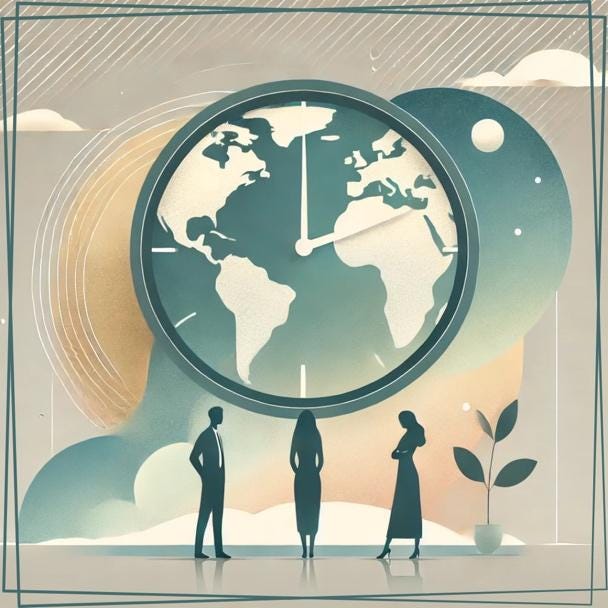
El futuro de la moda sostenible no depende exclusivamente de las marcas y gobiernos, sino también de la determinación individual de los consumidores. Desde buscar información activamente hasta exigir transparencia y apoyar iniciativas sostenibles, cada decisión cuenta. Dejar de esperar y empezar a actuar es el primer paso para transformar la industria textil y de la moda en una más ética y responsable y las redes sociales, cuando se usan de manera estratégica y fundamentada, pueden ser una de nuestras mejores aliadas en este camino; no sólo para denunciar y presionar, sino también para educarnos, compartir información valiosa y construir una comunidad consciente y comprometida con el cambio.
La pregunta es: ¿te quedas esperando o tomas acción?
 .
.
Alicia Mares, Corresponsal
de Negocios y Moda en México
y Latinoamérica para
Fashion Network
Cecilia Manzur, Diseñadora
, Modelista de Vestuario y
Asesora de Imagen, Chil
Alfonso Martínez Equihua
Director General de Industrias
Marves y Co Fundador de re.colecto
Por: Silvia Jiménez de la Mora, Consultora en Imagen y Guardarropa Sostenible, AICI CIC,
Directora del Comité de Sustentabilidad para AICI Global.
English
From Passivity to Action: How Can Consumers Demand More Responsible Fashion?
By: Silvia Jiménez de la Mora, Image and Sustainable Wardrobe Consultant, AICI CIC,
Director of the Sustainability Committee for AICI Global.
Every day, we are bombarded with information about the environmental, social, and cultural crisis in the fashion industry. But are we really taking action or simply waiting for brands and governments to do it for us? It’s not just about buying less or recycling more, but about becoming agents of change who demand accountability and transparency. To better understand how we can do this, we interviewed three industry experts: Cecilia Manzur, Costume Designer, Modeler, and Image Consultant, Chile; Alicia Mares, Fashion Business Correspondent in Mexico and Latin America for Fashion Network; and Alfonso Martínez Equihua, CEO of Industrias Marves and Co-Founder of re.colecto.
Through their perspectives, we reiterate key strategies that every consumer can implement to drive real transformations in the industry.
Stop Waiting for Information: The Power of Knowledge
Cecilia Manzur emphasizes that one of the first steps to generating change is to stop waiting for information to come to us. As consumers, we must actively seek out data about brands, production processes, and sustainability. Asking stores about their recycling or manufacturing policies not only gives us tools to make better decisions, but also pressures companies to be more transparent.
Based on her experience as an image consultant, Cecilia also highlights that teaching others about responsible consumption, selecting quality garments, and exploring options, such as secondhand clothing, can make a difference. As a designer, she believes that change must also come from the industry, designing collections with sustainable materials and more ethical production processes.
On the other hand, Alfonso tells us that “consumers have much more power and responsibility in the fashion industry than they think. Every purchase sends a message to the market, and big brands are listening.”
Social Media: A Tool for Change?
Alicia Mares reminds us that in the digital age, consumers have unprecedented power. Previously, social movements required marches and protests; today, “it’s no longer word of mouth, it’s publication after publication,” she tells us. However, she warns that this power must be used responsibly. Misuse of information can discredit genuine efforts and divert attention from the real problems.
She also tells us that in addition to being a tool for denunciation and pressure, social media also functions as an inexhaustible source of information and knowledge. Now, through our social networks, we can question brands, share information about events and initiatives, and support sustainable projects, which leads consumers to make more conscious purchases. The key is to filter information, verify sources, and share content that truly adds value to the conversation, which will generate transformation.
He also tells us that the spread of campaigns, initiatives, consumer testimonials, etc. has proven to be a driver of change in the industry. When a brand is called out for unethical practices, media pressure can force it to modify its processes. But similarly, when a company implements responsible policies, consumers can amplify that message, generating demand for products and services aligned with sustainability; “a simple click can make a huge difference,” Alicia tells us.
Similarly, she highlights the importance of actively participating, for example by extending the lifespan of our clothes through repairing, recycling, and buying secondhand clothing. This not only reduces the environmental impact but also sends a clear message to the industry about the growing demand for sustainable alternatives. In this regard, Alfonso explains that re.colecto provides a much lower-impact opportunity to discard our clothes and presents the opportunity to give them a second life.
Transparency: The Missing Link between Consumers, Governments, and Brands
Both Cecilia and Alicia agree that the lack of transparency and communication from governments and brands hinders progress toward sustainable fashion. Cecilia tells us about Chile’s Extended Producer Responsibility Law (REP), which incentivizes companies to implement more responsible practices, giving them additional points in bidding processes and promoting waste collection. Alicia also shares about initiatives such as the “Original” fair, which supports artisans, and Mexico’s ban on animal testing for cosmetics. These are important advances, but their limited publicity means they go unnoticed.
Similarly, Alfonso stipulates that “in Mexico, there is still a long way to go in regulations that encourage a more sustainable textile industry. He tells us that “there is talk of extended producer responsibility,” but that “consumer co-responsibility is also key” and that “the solution lies not only with brands or governments: it lies in greater awareness about how we choose, use, and dispose of our clothing.”
Furthermore, he tells us that by demanding transparency in responsible production and the use of more durable materials, brands will continue to listen and there will be a greater positive impact.
If governments and brands were more open and transparent about their projects, actions, and policies, greater awareness would be generated among consumers. Effective and transparent communication would not only allow people to make better decisions but would also encourage more companies to adopt sustainable practices, Alicia comments. Alfonso adds that “if there were more clear information about regulations and responsible practices, from both governments and brands, consumers could make better decisions.” He tells us that “transparency generates trust and commitment.”
The Most Urgent Request for Brands and Governments
If they could ask for a single immediate action, Cecilia, Alicia, and Alfonso have clear requests. Cecilia points out the need to regulate the import of textiles from the north, since, as is well known, tons of clothing end up in desert landfills without any control. Implementing stricter regulations in this regard would demonstrate a true government commitment to sustainability.
Alicia, on the other hand, emphasizes that the key is transparency. If brands and governments don’t communicate what they are doing (or what they aren’t doing), consumers are left in the dark, without the tools to demand real improvements.
For Alfonso, the push toward a way of working where producers and consumers actively participate in the circular economy is essential, and he emphasizes that “it’s not enough to produce better; we must also consume better and reduce waste.”
Don’t Wait for Change, Be the Change
The future of sustainable fashion depends not only on brands and governments, but also on the individual determination of consumers. From actively seeking information to demanding transparency and supporting sustainable initiatives, every decision counts. Stopping waiting and starting to act is the first step toward transforming the textile and fashion industry into a more ethical and responsible one. Social media, when used strategically and thoughtfully, can be one of our greatest allies on this path; not only to expose and pressure, but also to educate ourselves, share valuable information, and build an aware community committed to change.
The question is: do you wait or do you take action?
By: Claudia Castanheira – Communications Manager at Fashion Revolution Brasil

After two weeks of complex negotiations and over a day of delays, COP29 concluded with the resignation of the poorest and most vulnerable countries, forced to accept a climate finance deal far below the $1 trillion annually demanded by 2035. The final agreement settled on $300 billion per year for climate financing until 2035, the result of over 30 hours of tense talks and setbacks.
Countries in the Global North, including the European Union delegation, the United States, and Canada, who advocated for less ambitious targets, were widely criticized by international observers and NGOs. The European bloc was even awarded the “Fossil of the Day” on November 20, a symbolic prize given by the Climate Action Network (CAN) to those seen as blocking progress during climate talks.
It’s important to highlight that without adequate financial resources, it will be impossible for countries — particularly those in the Global South — to implement climate actions for adaptation, mitigation, and a just energy transition. This lack of funding also puts the Paris Agreement’s goal of limiting global warming to 1.5°C at risk.
Another notable point was the lack of clear commitments to energy transition — including the phase-out of fossil fuels, a central theme of COP28 in Dubai. This objective, removed from the final document in 2023, was not explicitly reinstated in the agreement signed on Saturday, marking a victory for oil and gas-producing countries.
In a geopolitical context marked by wars and crises, achieving significant progress was expected to be a challenging task. However, the general feeling is that this COP resulted in few, if any, meaningful achievements, increasing distrust in the multilateral process to address the climate crisis.
Fashion at COP29
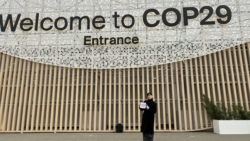
Fashion Revolution Brazil took part in COP29, engaging in discussions with civil society and other stakeholders to highlight the crucial role of fashion and textiles in addressing the climate crisis.
While formal negotiations left much to be desired, we came out stronger: Building new connections and forging global partnerships, which are essential for driving transformation in the industry.
As a civil movement, being part of these spaces is absolutely necessary. Even in the face of roadblocks and insufficient decisions, we reaffirmed our commitment to pursue a more transparent, fairer, and more sustainable fashion industry.
As members of the Brazilian delegation, we put forward clear demands:
For brands:
- Be transparent about how and where clothes are made, how many pieces are produced, and the social and environmental impacts of their production.
- Set ambitious targets for decarbonization and degrowth, and be clear about how these goals will be achieved.
- Publicly share updates on progress and concrete actions to meet these targets.
For policymakers:
- Develop policies to support Brazil and other garment-producing countries facing climate crises and vulnerabilities.
- Prioritize efforts to cut greenhouse gas emissions in the global fashion industry.
- Ensure small suppliers and family farmers have access to financial resources to build resilience against climate change.
At the event, we presented key reports, including What Fuels Fashion, a climate-focused analysis of the Global Fashion Transparency Index, and the latest edition of the Fashion Transparency Index Brazil, which reviews six years of progress and challenges in the industry.
COP30: What is next?
 Looking ahead, our goal is to mobilize the world’s largest civil movement for fashion to come together at COP30 in Belém, Brazil. This will be a landmark event: Brazil is the world’s top exporter of cotton, yet it faces major challenges like carbon emissions from deforestation and a dependency on fossil fuels.
Looking ahead, our goal is to mobilize the world’s largest civil movement for fashion to come together at COP30 in Belém, Brazil. This will be a landmark event: Brazil is the world’s top exporter of cotton, yet it faces major challenges like carbon emissions from deforestation and a dependency on fossil fuels.
The takeaway from COP29 is clear: COP30 must tackle the issues that remain unresolved. We’ll be there in the Amazon rainforest, demanding an end to fossil-fueled fashion and advocating for the rights of those most affected by the climate crisis, often the women who make our clothes.
The fashion climate agenda is just getting started!
Standing together with #FashionforClimate
What can you (citizens) do?
HEY BIG FASHION BRANDS,
START FINANCING YOUR DECARBONISATION NOW!
COP29, the 29th Conference of the Parties to the United Nations Framework Convention on Climate Change, is poised to be a pivotal event in the global fight against climate change. As usual, the conference will bring together world leaders, negotiators, and stakeholders to assess progress on climate commitments made during previous COP meetings and to discuss strategies for achieving the goals of the Paris Agreement. But we are all fatigued from discussions and commitments, the time is running out and we urgently need action.
As many stakeholders are referring to COP29 as ‘the finance COP’, with negotiations seen as critical to advance a range of financial tools and instruments to support actions to address climate change, we want to reinforce our calling on major fashion brands to invest at least 2% of their revenue in a fair transition away from fossil fuels – like coal – to renewable energy sources – like wind and solar – to power fashion’s supply chain in a clean way.
Fashion is fueling the climate crisis, and major fashion brands must urgently put their money where their emissions are.
Fashion is one of the most polluting industries on the planet, with fossil fuels burned at every stage of production. The industry alone is set to overshoot the 1.5°C limit by 50%, doubling emissions rather than halving them as the science is crying out for. Frequent climate catastrophes, like extreme heat, flooding, and droughts are devastating the livelihoods of workers across global garment supply chains, with extreme weather estimated to cost nearly one million jobs by 2030.
Fashion Revolution’s new report, What Fuels Fashion? reviewed 250 of the world’s largest fashion brands and retailers and ranked them according to their level of disclosure on climate and energy-related data in their operations and supply chains. The findings revealed that major fashion brands aren’t doing enough to cut fossil fuel use in their supply chains. 86% of major fashion brands lack a public coal phase-out target, and only 3% disclose the level of financial support provided to supply chain workers affected by the climate crisis.
By investing at least 2% of their revenue into clean, renewable energy and upskilling and supporting workers, fashion could simultaneously curb the impacts of the climate crisis and reduce poverty and inequality within their supply chains. Climate breakdown is avoidable because we have the solution – and big fashion can certainly afford it.
Our Demands for Fashion Brands:
- Tell us about your clothes: How and where they were made, how many were produced.
-
- Disclose your annual production volumes
- Disclose the fiber mix of your clothes and why are these fibers
- Disclose the prices you pay to suppliers for each item and the wages that workers receive for the production of your garments
- Tell us about your impact: Measure your environmental and social impact and disclose it.
- Disclose your supplier lists (Tier 1 and Tier 2) in an open source easy to usee for others (such as excel, csv or json)
- Disclose your fuel mix across your supply chains by country
- Publish a detailed breakdown of renewable energy procurement type in your operations and supply chain
- Tell us how you are leveraging your power to influence and advocate for a decarbonisation process and just transition in your supplying countries
- Tell us about your targets: Set targets, disclose how you established them, how you plan to meet them, and report on progress.
- Disclose your climate targets, including your supply chain, backed up by a decarbonisation strategy. Oh and don’t forget to share how were suppliers consulted in the establishment of those targets.
- Publish evidence of climate action in the supply chain and how these efforts are reducing greenhouse gas emissions while increasing renewable energy capacity.
- Share how you are supporting your suppliers for a just transition
Our Demands for Policymakers:
- Implement Binding Regulations: Require transparency and corporate accountability on environmental and human rights issues in the global fashion industry.
- Responsible Purchasing Practices: Ensure brand payments to suppliers reflect the true costs of sustainable production.
- Finance the Green Transition: Develop policies that support garment-producing countries facing debt crises and climate vulnerabilities, prioritizing actions to reduce greenhouse gas emissions.
- Direct Financial Support for Suppliers: Facilitate access to financial resources for suppliers to enhance resilience to climate change, with flexible repayment terms and simplified loan processes.
- Equitable Decision-Making Models: Create decision-making frameworks informed by affected stakeholders, ensuring local contexts and regional needs are integrated into climate action planning and implementation.
What can you (citizens) do?
- You can read the What Fuels Fashion report here and share!
- Email your brands here
- Donate here to keep our revolution going
IT’S TIME FOR FASHION BRANDS TO PUT THEIR MONEY WHERE THEIR EMISSIONS ARE
Fashion Revolution, the world’s largest fashion activism movement, is at Climate Week NYC 2024 with a clear message: fashion is fueling the climate crisis, and major fashion brands must urgently put their money where their emissions are.
We’re calling on major fashion brands to invest at least 2% of their revenue in a fair transition away from fossil fuels – like coal – to renewable energy sources – like wind and solar – to power fashion’s supply chain in a clean way.
Fashion is one of the most polluting industries on the planet, with fossil fuels burned at every stage of production. The industry alone is set to overshoot the 1.5°C limit by 50%, doubling emissions rather than halving them as the science is crying out for. Frequent climate catastrophes, like extreme heat, flooding, and droughts are devastating the livelihoods of workers across global garment supply chains, with extreme weather estimated to cost nearly one million jobs by 2030.
Fashion Revolution’s new report, What Fuels Fashion? reviewed 250 of the world’s largest fashion brands and retailers and ranked them according to their level of disclosure on climate and energy-related data in their operations and supply chains. The findings revealed that major fashion brands aren’t doing enough to cut fossil fuel use in their supply chains. 86% of major fashion brands lack A PUBLIC coal phase-out target, and only 3% disclose the level of financial support provided to supply chain workers affected by the climate crisis.
By investing at least 2% of their revenue into clean, renewable energy and upskilling and supporting workers, fashion could simultaneously curb the impacts of the climate crisis and reduce poverty and inequality within their supply chains. Climate breakdown is avoidable because we have the solution – and big fashion can certainly afford it.
WE ARE CALLING ON
- Policymakers to enhance regulation
- Investors to fund and co-fund renewable energy and decarbonisation projects
- Citizens to use their voice- email major brands and retailers and call on them to invest at least 2% of their annual revenues into their decarbonisation and Just Transition efforts
- Civil society, academia, journalists to leverage data and findings to scrutinise and verify the public claims made by brands
Big fashion can no longer mask its lack of decarbonisation progress with vague, insufficient targets and pilot projects that fail to benefit most of the supply chain. The need for system change is undeniable. It’s time for brands to put their money where their emissions are.
You can read the report here. Email your brands here.Fashion Revolution is at COP28 in Dubai this year, alongside Fashion Revolution teams from the UAE, India, Brazil and Pakistan to bring our global voice to the table and advocate for systemic change. In this opinion piece by Liv Simpliciano, our Policy and Research Manager, you can find out more about this year’s conference and what we are demanding from brands below.
What is COP28?
The first Conference of the Parties (COP) was held in 1995. Though the warnings have grown louder, each year we have edged closer toward climate breakdown. Repeated warnings followed by calls to actions and policies have seemingly rung hollow, as they have been inadequate to slow the rate of global warming.
Two years ago, we first attended COP26 in Glasgow. We were told by other attendees that they hoped fashion would be taken seriously by policymakers. However, fashion’s impact on the people and planet has always been serious when talking about the climate crisis.
COP28 is poised to be a global stocktake on progress since the Paris Agreement came into being five years ago. It’s devastatingly clear that countries’ emissions have risen, as have fashion brands’. Major fashion brands need to phase out fossil fuels and phase up renewables – the actions we take now will be the make or break of generations to come.
This COP, the Fossil-Fuel Non-Proliferation Agreement is on the table and seeking a negotiating mandate. The proposed treaty would complement the Paris Agreement by providing the global roadmap needed to halt the expansion of fossil fuel, manage an equitable phase-out of coal, oil and gas, and lay the foundations for a true just energy transition in which no worker, community or country is left behind.
For too long, addressing only emissions reductions and demand without fossil fuel supply has meant countries and companies can continue to claim climate leadership whilst opening, approving and funding new fossil fuel projects. This has to end.
When it comes to fashion, evidence resoundingly demonstrates that the industry is one of the most polluting industries in the world and is one of the core industries driving the pollution of our shared planet. Not only this, it is also one of the wealthiest and most unequal industries in the world. Oxfam’s latest report finds that the richest 1% account for more carbon emissions than the poorest 66% – fashion CEOs are some of the wealthiest people on this planet. It takes just four days for a fashion CEO to earn what a garment worker would earn in their entire lifetime.
View this post on Instagram
Transparency is critical when it comes to addressing the most pressing issues in the fashion industry. A lack of transparency is a continued barrier when it comes to accelerating meaningful impact. Accountability must be unlocked for civil society organisations, citizens, NGOs, worker rights organisations and governments to hold major fashion brands accountable and that is facilitated first and foremost through access to information. There is a persistent lack of transparency when it comes to:
- How many clothes are produced annually and their environmental impacts
- Brands setting robust climate targets, publishing how they were established and reporting on progress
- How brands plan on actually meeting these targets
We have repeatedly seen time-bound targets come and go. There are bare minimum asks that brands should be able to disclose. For example, brands continue to be un-transparent about their annual production volumes – despite the increasing visibility of the fashion industry’s waste problem globally. Brands do not shy away from making bold commitments but these commitments across their supply chains are often made without input from their suppliers who hold important context. There’s no silver bullet solution to the problems in the fashion industry. The needs of supply chain stakeholders are not a monolith and must be addressed with specific context in mind. Top down decision making coupled with the industry’s characteristic unfair purchasing practices are placing pressure on suppliers to be responsible for fixing fashion. Without major fashion brands’ financial commitment and willingness to share financial risk when it comes to decarbonising their supply chains for example, progress will continue to be impeded and with disastrous impacts.
Fashion brands often use COP to announce glossy commitments. Our research in the 2023 Global Fashion Transparency Index shows that once again this year, while brands are telling us more about their policies and commitments, they are telling us much less about what these policies and commitments have achieved. And in the absence of disclosed evidence, it is difficult to understand if the fashion industry is turning things around. We don’t need more commitments – we need more progress.
The stark reality of our planet is that the latest Emissions Gap report finds we are on track to warm by nearly 3 degrees C without aggressive actions, with current levels barreling toward a ‘point of no return’. It is so clear that fashion needs to stop prioritising the money and start listening not only to the science, but to the needs and interests of their suppliers and the people who make our clothes. This has been the case for a very long time and yet when it comes to basic transparency on how brands are performing on their climate targets – a huge lack of transparency (and therefore accountability) remains: less than a third of the 250 major fashion brands reviewed disclose progress on decarbonisation. Aggressive actions are impeded by the lack of transparency because it inhibits the true scale of the problem and obscures where the greatest responsibility for action lies.
Finally – in order to ensure action and progress – policymakers must implement binding regulations, laws and government policies that require transparency and corporate accountability on environmental and human rights issues in the global fashion industry. Without mandatory regulations, major fashion brands can continue to hide from addressing their impacts.
Ultimately, major fashion brands hold the potential to lead the clean energy transition based on their powerful economic influence in their sourcing countries and must leverage this to deliver real renewable energy capacity. Ultimately, there is no fashion on a dead planet.
Read our demands
Header photo by Jay Wennington on Unsplash
This is a guest post written by Taylor Brydges, Research Principal, and Samantha Sharpe, Research Director, at the Institute for Sustainable Futures, at the University of Technology Sydney (UTS) . The European Environmental Bureau (EEB) commissioned a team from UTS, the Institute for Sustainable Futures (ISF), Erasmus University Rotterdam and Lund University to develop the concept of a ‘Wellbeing Wardrobe’ – a fashion and textiles industry that is oriented towards a Wellbeing Economy.
Clothes are an essential part of our daily lives. While our clothing choices reflect our culture and identity, our clothing and the fashion industry’s environmental impact can’t be ignored.
Fashion is one of the most unsustainable industries in the world based on environmental and social sustainability metrics. Over the past decades, the sector’s rapid growth has been fueled by overproduction and overconsumption of garments. Recognising that fashion has become one of the most unsustainable industries in the world also requires us to confront the reality that we need a new way forward.
However, many of the current sustainability initiatives in the fashion industry are based on green-growth approaches that put economic opportunity before environmental concerns. At the core of many of these business models are initiatives that do not fundamentally overhaul the industry or allow it to operate within planetary boundaries. Examples of such approaches include shifting to more sustainable fibres and textiles, providing a limited range of ethically conscious options, or introducing ‘green’ certification and labelling systems.
Although these initiatives provide some progress, they ultimately fail to enable the industry to reduce material consumption or prevent the unnecessary disposal of clothing and textiles. This failure results in increased carbon emissions, natural resource utilisation, and biodiversity loss. If the fashion industry doesn’t change its current trajectory, it might consume over 26% of the carbon emissions allowance linked to a 2-degree Celsius limit on global warming by 2050.
Introducing The Wellbeing Wardrobe
Our recent report, The Wellbeing Wardrobe, set out to explore how we can achieve a post-growth fashion industry. We found this will require far-reaching reforms beyond the fashion industry and a reconceptualisation of societal roles and responsibilities. This led us to focus on the wellbeing economy.
The “wellbeing economy” concept encompasses various alternative economic models, including degrowth, post-growth, and steady-state economics. It aims to shift our focus from economic growth to human and ecological wellbeing.
Applied to the fashion industry, we use the concept of the wellbeing wardrobe to examine a new way forward for fashion in which we favour human and environmental wellbeing over the growing consumption of fashion.
The Wellbeing Wardrobe identifies four guiding principles for a sustainable, thriving fashion and textile sector:
- Establish limits: A wellbeing economy approach limits resource use and consumption and shows people how they can still live well while respecting these boundaries. Examples of how the fashion industry is making changes to set boundaries and promote sustainability include slow fashion, increased attention and support to repairing clothes, and campaigns to raise awareness of reusing and refashioning garments. Despite the uptake of circular solutions, the 2023 Fashion Transparency Index shows us that the industry is currently failing to tackle overproduction;only 1% of major fashion brands have committed to reducing the production of new clothing items.. A mere 12% disclose the total volume of products they manufacture annually, hiding the true scale of their excessive production. Furthermore, only 1% of major brands openly commit to embracing degrowth.
- Promote fairness: Equitable wealth distribution systems are needed to ensure global and intergenerational fairness. Despite the conversations happening around this topic, the 2023 Fashion Transparency Index found that just 5% of brands disclose their investment in supply chain workers for a Just Transition to a Circular Economy. This absence of funding speaks volumes about the industry’s interest, or lack thereof, in workers’ wellbeing and ensuring they are not left behind as brands explore new methods of production.
- Create healthy and just governance: Robust, participatory, deliberative processes that emphasise inclusivity, open dialogue and diversity are key to creating lasting change. Good governance encourages capacity-building and stakeholder engagement across every level of the fashion industry. Within existing policy frameworks, we can launch citizen assemblies on wellbeing indicators for our economy and create balanced multi-stakeholder deliberative processes accompanying EU and national authorities.
- Embrace new exchange systems: Innovative exchange models can ensure the fashion industry thrives while meeting human and environmental wellbeing needs by providing dignified work, regenerating the environment, and strengthening community bonds. We see a number of these systems of exchange taking hold. B-corps, ecopreneurs, swapping and second-hand shopping are all examples of innovative practices aimed at creating a sustainable and equitable fashion ecosystem.
All of these initiatives are helping to transform the fashion industry and create a more sustainable and equitable future for fashion. Transitioning to a post-growth fashion and garment sector will require wide-ranging reforms and a broad reconceptualisation of consumer, brand, and policymaker roles and responsibilities. With 30% of brands surveyed in the 2023 Fashion Transparency Index offering new business models that slow consumption, there is a foundation to build on in the sector, but the overwhelming majority of brands are still failing to adapt.
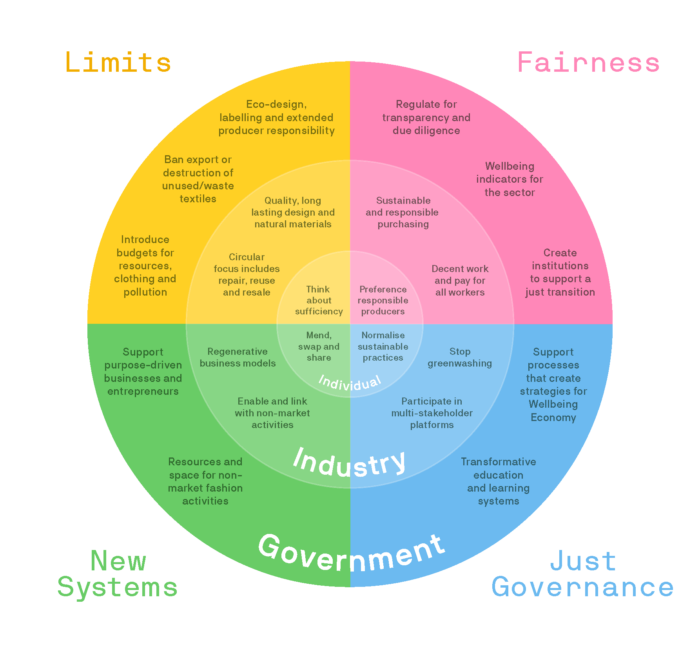
Actions for Consumers, Brands and Policymakers
As citizens and consumers, we can embrace sustainability in the fashion industry by focusing on sufficiency, responsible consumption, and promoting new systems of exchange. This involves considering what sufficiency means to us regarding our fashion consumption. This will vary from person to person depending on environmental and lifestyle factors, including individual notions of well-being and the pursuit of a satisfying life, which are influenced by gender and social class.
Adopting practices that promote sufficiency include buying fewer new clothes, taking better care of existing ones, opting for second-hand shopping, and participating in clothing exchanges. When deciding to purchase something, we should try to support responsible brands, wherever possible, choose second-hand over new, and participate in practices such as mending, swapping, and sharing to keep what we already own in use longer and make Loved Clothes Last. More broadly, there is a need to encourage the normalisation of sustainable practices at the community level, fostering a collective commitment to eco-conscious living.
For brands that make the majority of our clothes, there needs to be a focus on adopting sustainable practices that revolve around quality, durable design, and using natural materials, while promoting circular approaches, including repair, reuse, and resale. Above all, there needs to be a dramatic reduction in the number of new clothes being produced. Fairness is upheld by ensuring sustainable and responsible purchasing, along with decent working conditions and fair pay for all industry workers. New business models should be regenerative and connected to non-market activities, aligning industry practices with ecological and ethical principles. Just governance demands an end to greenwashing and active participation and accountability of sector stakeholders in multi-stakeholder platforms.
And finally, policy plays a pivotal role in advancing wellbeing approaches, such as through regulating the implementation of eco-design, sustainability labelling, and extended producer responsibility. The export or destruction of unused or waste textiles must be banned while considering how to introduce resource, clothing, and pollution budgets. Fairness in the sector can also be supported through regulations that ensure transparency and due diligence, the incorporation of well-being indicators for the sector, and establishing the institutions that will support a just transition.
Our Wellbeing Wardrobe policy framework encourages the support of purpose-driven businesses and entrepreneurs, allocating resources and space for non-market fashion activities. It also advocates for just governance through processes that foster strategies for a wellbeing economy and transformative education and learning systems.

A Path Forward
The fashion industry is at a crossroads where our choices today will shape our future. The urgency of addressing fashion’s environmental and social challenges cannot be overstated. The Wellbeing Wardrobe provides a path forward for an industry that prioritises human and environmental wellbeing over the relentless pursuit of fast fashion. Our four guiding principles – establishing limits, promoting fairness, creating healthy and just governance, and embracing new exchange systems – provide a roadmap for this transformation.
This transformation will require collective action from citizens, consumers, brands, and policymakers. As we contemplate what sufficiency means to each of us and integrate sustainable practices into our lives, we must also hold brands accountable for sustainable and ethical practices. Policymakers must enact regulations that support these principles, creating a foundation where purpose-driven businesses can thrive.
Together, we can forge a path towards a more sustainable, equitable, and wellbeing-focused industry.
Further reading
Slow down & scale back: Degrowth in the Fashion Industry
War on Want: Fashioning the Future
Header Image by drobotdean on Freepik
The fashion industry is set to face a wave of legislation across the EU and worldwide as governments finally begin acting on brands’ false sustainability claims, environmental destruction and human rights abuses. In the era of rampant greenwashing and worsening inequality, these policies are desperately needed.
Major fashion brands which sell to the EU – the largest importer of clothes in the world – are preparing to be legally required to disclose their due diligence procedures. It’s therefore no surprise that brands ranked in the Fashion Transparency Index collectively score higher on every indicator in human rights and environmental due diligence, compared to last year.
More brands than ever are disclosing their approach to due diligence; how affected stakeholders are consulted; salient risks identified; and which steps are taken to address these risks and the outcomes, in both their human rights and environmental due diligence. Upcoming legislation on due diligence, including the Corporate Sustainability Due Diligence Directive (CSDDD) and the Corporate Sustainability Reporting Directive (CSRD) at EU level have contributed to this uplift, as have similar efforts in Japan, Germany, the US and more.
But it’s not all good news. Major fashion brands remain far stronger at describing their identified risks, socially and environmentally, than the outcomes and impacts of due diligence. Transparency of the due diligence processes is foundational – but it is vital that brands also disclose its impacts and outcomes too. Transparency on how brands deliver on their commitments is the bare minimum that we can expect and yet, many brands are still reluctant to do so until they are legally mandated to do so – which, with upcoming legislation, will hopefully be very soon.
To delve deeper into this topic, we invited a range of industry experts and policymakers to provide their perspectives on the need for greater transparency and stringent legislation to tackle the fashion industry’s most pressing issues. Here, you can explore some viewpoints featured in the Fashion Transparency Index 2023.
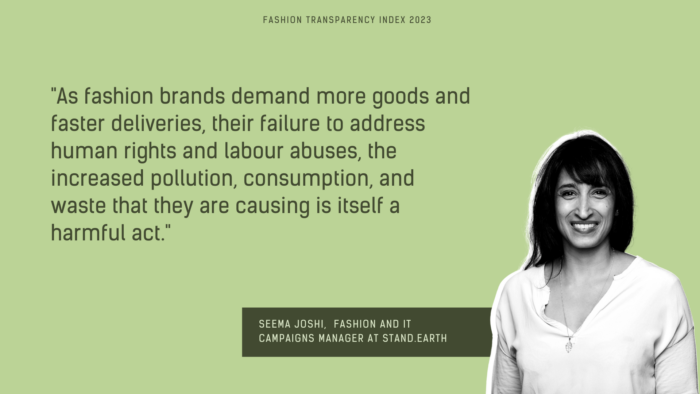
THE FASHION INDUSTRY SHOULD DO NO HARM
Seema Joshi, Fashion and IT Campaigns Director, STAND.EARTH
The fashion industry is facing growing scrutiny to ‘do no harm.’ As a top global emitter, the fashion industry has a responsibility to take proportionate, proactive steps to prevent, identify and address harmful human, environmental and climate impacts originating from its factories and supply chain. Despite this outsized responsibility, according to this year’s Index findings, just 22% of brands disclose the outcomes of steps taken to address environmental issues identified as part of their environmental due diligence and even less (20%) disclose the outcomes of their human rights due diligence.
It’s no coincidence that the places where many fashion brands are offshoring the vast majority of their manufacturing are under-resourced areas in the Global South – where human rights and environmental protections are often poorly enforced, and companies can cheaply export the products and profits back to western countries. As fashion brands demand more goods and faster deliveries, their failure to address human rights and labour abuses, the increased pollution, consumption, and waste that they are causing is itself a harmful act.
Legal action, coupled with emerging regulations in Europe and North America, shows the importance of industry actors being able to prove that they have acted responsibly at all levels of production. The Fashion Revolution’s Transparency Index is an invaluable industry benchmark, which companies can use to show that they have taken the right steps and complied with relevant laws and international standards. This, in return, could protect them against accusations of poor behaviour.
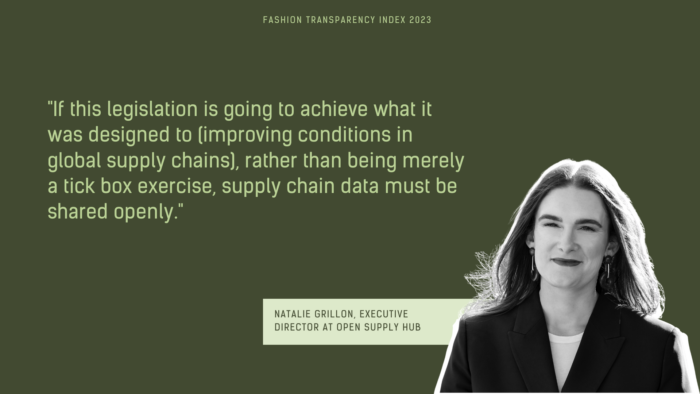
“As the wave of supply chain due diligence and reporting legislation being enacted globally continues to grow, the resulting increase in the volume of apparel brands and retailers choosing to share their supplier data on Open Supply Hub is notable – and encouraging. If this legislation is going to achieve what it was designed to (improving conditions in global supply chains), rather than being merely a tick box exercise, supply chain data must be shared openly, and in a format that enables organisations to work with it practically and efficiently – machine readable, and available for download as an Excel or CSV file. In turn, this will accelerate opportunities for collaboration, as organisations are quickly able to identify shared connections at global production sites. We applaud the brands who have moved ahead of the curve to do just that.”
Natalie Grillon, Executive Director, Open Supply Hub
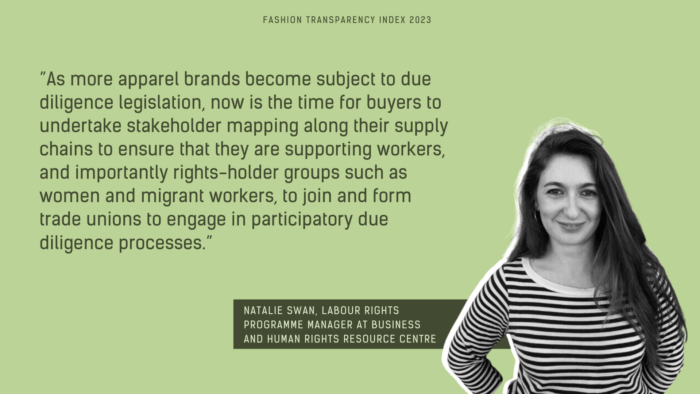
SLOW PROGRESS AND THE TICKING CLOCK OF CHANGE
Urska Trunk, Campaign Manager, Changing Markets Foundation
In the realm of fashion, governments around the world are promising to finally regulate an industry long plagued by unsustainable practices. A wave of approaching legislation should serve as a wake-up call for the fashion industry that prioritising genuine sustainability is no longer optional but necessary.
However, according to this year’s Fashion Transparency Index data, it is as if the fashion industry missed the memo. The progress on transparency and sustainable practices are frustratingly slow, suggesting that many brands might be just paying lip service to green practices and will eventually find themselves left behind in the aftermath of the regulatory storm. In an industry that claims to prioritise ethical and responsible practices, it should be commonplace for brands to openly share information about the types of fibres they use. This transparency serves as the foundation for building trust and fostering responsible consumption. Yet over two thirds (71%) of brands are still tiptoeing around the issue and failing to disclose the percentage or tonnes of fibres used.
While 51% of brands have disclosed sustainable materials strategy, roadmap, or targets, a glaring disparity emerges when compared to the mere 27% of brands actively reporting progress on reducing reliance on virgin fossil fuel-based fibres. This raises a critical question: can a sustainable materials strategy truly exist without addressing the need to reduce both virgin and recycled synthetic materials?
The industry’s selective approach to sustainability that conveniently ignores the link between synthetics and the destructive model of fast fashion, reeks of greenwashing. Despite the European Commission’s EU strategy for sustainable textiles highlighting this connection, the industry continues to turn a blind eye. Shockingly, our research from 2022 revealed that a quarter of major fashion companies increased their reliance on fossil-fuel-derived fibres during the climate emergency. Moreover, our greenwash.com website reveals that brands’ main sustainability materials strategy involves making clothes from plastic bottles; a false solution, as these items are much more likely to end up in landfill than if they were recycled to bottles.
Furthermore, brands are also reluctant to confront overproduction and microplastic pollution. A mere 12% of fashion companies, down from 15% the previous year, disclose the quantity of products produced annually. Most disappointingly, as studies continue to shed light on the devastating environmental and human health impacts of microplastics, less than a quarter of brands (22%, down from 24% last year) disclose what they are doing to minimise the impact of microfibres. This discrepancy between grandiose sustainability claims and sluggish progress on these crucial issues, lays bare the dark side of greenwashing.
In a decade since the tragic Rana Plaza incident, the slow progress in the industry is disheartening. However, upcoming legislation offers hope for reshaping the landscape, increasing clothing sustainability, and holding brands accountable. It will deliver a blow to insidious greenwashing tactics and require substantial evidence for sustainability claims. This will restore trust, empower consumers, and encourage genuine sustainability practices, leaving behind the days of vague claims and empty promises.
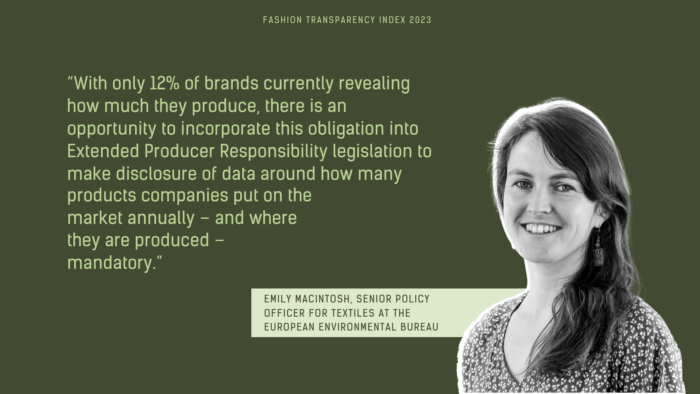
“The fast fashion model that exploits both people and the planet’s finite resources must come to an end. The welfare of people and the planet takes precedence over the textile industry’s pursuit of profits. Textile supply chains show that human rights and environmental consequences cross borders and our responsibility is global. Many voluntary measures and commitments by companies have taken an important step in the right direction, but the reality shows that these are far from enough. We as the EU must lead by example and ensure that the textiles sold in our shops guarantee high environmental and human
rights standards. To achieve this we need binding legislation. That’s why I call for European legislation that guarantees that fashion is not produced at the cost of environmental destruction and human lives. As rapporteur in the Environment Committee for sustainable textiles, I am fighting for this!”
Delara Burkhardt, Member of European Parliament, The Progressive Alliance of Socialists and Democrats
You can read more about upcoming legislation and how brands are responding to this change in the 2023 edition of the Fashion Transparency Index.
Header photo by Wesley Tingey on Unsplash
Fashion Revolution Week is our annual campaign bringing together the world’s largest fashion activism movement for seven days of action. It centres around the anniversary of the Rana Plaza factory collapse, which killed around 1,138 people and injured many more on 24 April 2013.
This year, as we marked the tenth anniversary of the Rana Plaza factory collapse, we remembered the victims, survivors and families affected by this preventable tragedy and continue to demand that no one dies for our fashion. To define the next decade of change, we translated our 10-point Manifesto into action for a safe, just and transparent global fashion industry. Our campaign platformed the work of our diverse Global Network who provided local interpretations of their chosen Manifesto point(s). We believe that while fashion has a colossal negative impact, it also has the power and the potential to be a force for change. Together, we expanded the horizons of what fashion could – and should – be.
Here, catch up on some of the week’s highlights and find out how to stay involved with our work, all year round.
Remembering Rana Plaza
Fashion Revolution Week happens every year in the week coinciding with April 24th, the anniversary of the Rana Plaza disaster. On April 24th 2013, the Rana Plaza factory building in Bangladesh collapsed in a preventable tragedy. More than 1,100 people died and another 2,500 were injured, making it the fourth largest industrial disaster in history. On April 24th, we paused all other campaigning to pay our respects to the victims, survivors and families affected by this tragedy, and came together as a global community to remember Rana Plaza.
As we reflect a decade on, we are inspired by and celebrate the progress made in the Bangladesh Ready-made Garment (RMG) sector by the Accord. The International Accord on Fire and Building Safety was the first legally-binding brand agreement on worker health and safety in the fashion industry and is the most important agreement to keep garment workers safe to date. This year, we pay tribute to the joint efforts of all Accord stakeholders who have significantly contributed to safer workplaces for over 2 million garment factory workers in Bangladesh, including the Bangladeshi trade unions representing garment workers, alongside Global Union Federations and labour rights groups. We welcome the introduction of the Pakistan Accord and would like to see the adoption and success of the International Accord replicated in all garment producing countries.
Manifesto for a Fashion Revolution
Our theme for Fashion Revolution Week 2023 was Manifesto for a Fashion Revolution. Back in 2018, we created a 10-point Manifesto that solidifies our vision to a global fashion industry that conserves and restores the environment and values people over growth and profit. This year we called on citizens, brands and makers alike to sign their name in support of turning these demands into a reality, boosting our signature count to 15,500 Fashion Revolutionaries and counting. We are immensely grateful to everyone who has and continues to sign; our power is in our number and each signature strengthens our collective call to revolutionise the fashion industry.
To campaign for systemic change in the fashion industry, we themed the week around complementary Manifesto points, providing ways to be curious, find out and do something daily around each of them. From supply chain transparency to living wages, textile waste to cultural appropriation, freedom of association to biodiversity, we shared global perspectives and solutions to fashion’s most pressing social and environmental problems.
Over the past ten years, the noise around sustainable fashion has only got louder. But meanwhile, real progress is too slow in the context of the climate crisis and rising social injustice. That’s why Fashion Revolution Week 2023 was an action-packed and future-focused campaign that amplified the actions and perspectives of Fashion Revolutionaries around the world.
View this post on Instagram
Global Conversations
To capture these global perspectives, we launched the Fashion Revolution Map on Earth Day, which coincided with the start of Fashion Revolution Week. Developed by Talk Climate Change, the Map served as a global forum to reflect on the week’s themes and events, using our Manifesto as a talking point. Fashion Revolutionaries continued the discussion offline by inviting their family, friends, colleagues and classmates to imagine what a clean, safe, fair, transparent and accountable fashion industry would look like with us. These conversations were then recorded on the Map as a source of inspiration and knowledge exchange.
Anyone can be a Fashion Revolutionary; it starts with a simple dialogue about the changes you want to see in the fashion industry. Make your voice heard by contributing to our map today and help change the fashion industry through the power of conversation!
View this post on Instagram
Good Clothes, Fair Pay Highlights
Ten years on from Rana Plaza, poverty wages remain endemic to the global garment industry. Most of the people who make our clothes still earn poverty wages while fashion brands continue to turn huge profits. At Fashion Revolution, we believe there is no sustainable fashion without fair pay which is why we launched Good Clothes, Fair Pay as part of a wider coalition last July. The Good Clothes Fair Pay campaign demands living wage legislation at EU level for garment workers worldwide, building on Manifesto points 1 and 2.
During Fashion Revolution Week, our EU teams coordinated awareness events, campaigns and marches to mobilise signatures for this campaign. On April 25th, we headed to the European Parliament with Fashion Revolution Belgium to demand better legislation in the fashion industry. The day of action consisted of a panel discussion between Members of the European Parliament and impacted fashion stakeholders, and ended with a stunt outside the Parliament. Fashionably Late highlighted that the EU is running out of time to act on poverty wages in fashion. This stunt was replicated by our teams in Germany, France and the Netherlands throughout Fashion Revolution Week to demonstrate EU-wide solidarity with the people who make our clothes.
We have less than three months left to collect 1 million signatures from EU citizens to push for legislation that requires companies to conduct living wage due diligence in their supply chains, irrespective of where their clothes are made. If you are an EU citizen, sign your name here. If you’re unable to sign, please support the campaign by sharing it far and wide online.
View this post on Instagram
Fashion Revolution Open Studios Highlights
Fashion Revolution Open Studios is Fashion Revolution’s showcasing and mentoring initiative since 2017. Through exhibitions, presentations, talks, and workshops with emerging designers, established trailblazers and major players, we celebrate the people, products and processes behind our clothes.
This Fashion Revolution Week, Fashion Revolution Open Studios joined forces with Small but Perfect to spotlight the work of 28 European SMEs taking part in their circularity accelerator project. Forming part of this European events programme, Fashion Revolution Open Studios held a two-day event in partnership with The Sustainable Angle and xyz.exchange at The Lab E20. The event showcased seven innovative designers from the Small But Perfect cohort of sustainable SMEs and displayed how they are embedding circular solutions into their work, from crafting grape leather handbags to developing community approaches to making and working together. Alongside the exhibition, there were livestreamed webinars, workshops and panel discussions to explore the projects and hear about some of the the challenges facing small businesses and the industry at large in switching to circular business models.
Global Network Highlights
With 75+ teams from all around the world, Fashion Revolution Week 2023 championed the perspectives and contributions of our Global Network. Here are just a small selection of highlights from our country teams:
Fashion Revolution New Zealand unpacked each Manifesto point with industry trailblazers in an Instagram Live series.
Fashion Revolution teams in Bangladesh and Sweden co-organised a virtual panel discussion on shifting consumer behaviour.
Fashion Revolution Singapore celebrated the launch of their digital zine MANIFESTO.
Fashion Revolution teams in Iran and Germany collaborated on Women, Life, Freedom, a joint exhibition.
Fashion Revolution Nigeria shared the stories and journeys of local slow fashion brands.
Fashion Revolution Argentina invited us to join their Wikipedia edit-a-thon.
Fashion Revolution teams in Vietnam, South Africa and Scotland hosted local community clothing swaps.
Fashion Revolution India won the Elle Sustainability Award for Eco-Innovation in Fashion.
Fashion Revolution Uganda brought together the country’s top designers and brands at Kwetu Kwanza.
Fashion Revolution teams in UAE and Canada both held local design competitions for students.
Fashion Revolution Hungary championed the revival of traditional folklore practices in clothing and fashion.
Fashion Revolution USA discussed the fashion industry’s impact on people and planet in a 2-part Zoom series.
Fashion Revolution Uruguay hosted Fashion Celebrates Life, a community picnic themed around Manifesto point 10.
Fashion Revolution teams in Chile and Portugal shared their Fashion Revolution Week highlights with us on Instagram Live.
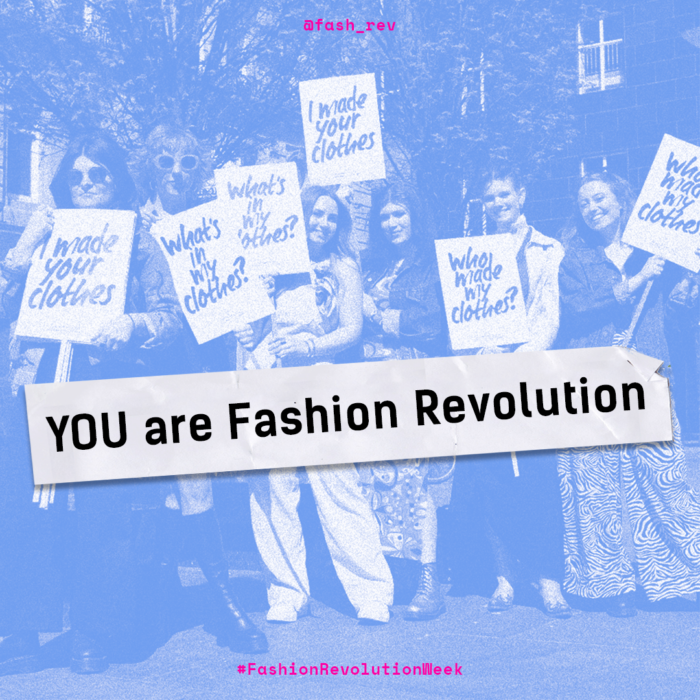
You are Fashion Revolution
We are so grateful to everyone in our community for getting involved in Fashion Revolution Week on social media and beyond. Every single voice makes a difference in our fight for a fashion industry that conserves and restores the environment and values people over growth and profit.
While Fashion Revolution Week 2023 may be over, our community, our campaigning and our movement continues, 365 days a year. Please join us in fighting for systemic change by:
Following us on social media: Stay up-to-date by following us on Instagram, Facebook, Twitter, TikTok, LinkedIn and YouTube, and signing up to our weekly newsletter.
Finding your country team: Connect with the teams in your region by following them online, attending their events and volunteering with them. Find your country team here.
Using our online resources: Our website is a treasure trove of information, from how to guides and online courses to annual reporting on transparency on the fashion industry. Get started here.
From all of us in the Fashion Revolution team, we appreciate your support and we look forward to seeing you next year!
Good Clothes, Fair Pay is our new campaign demanding living wage legislation across the garment, textile and footwear sector. We need 1 million signatures from EU citizens over the next 12 months to push for legislation that requires companies to conduct living wage due diligence in their supply chains.
Millions of people work in textile, clothing and footwear production around the world. The vast majority are not paid enough to fulfil their basic needs.These people remain trapped in poverty while big fashion companies continue to profit from their hard work. It is a deeply unfair and exploitative system, and we must demand better. The Covid-19 pandemic has deepened wage insecurity for the people who make our clothes, leaving workers without any social safety net, struggling to pay for food, healthcare and shelter.
This is why Good Clothes Fair Pay is calling on the European Commission to introduce legislation requiring that brands and retailers in the garment sector conduct specific due diligence in their supply chain to ensure workers are paid living wages.
The European Citizens’ Initiative is a unique instrument enabling citizens to call on EU policymakers to propose legislation in an area of EU competence. The campaign must collect at least 1 million signatures from EU citizens to reach the European Commission. You can read the full legal proposal here.
The scope covers brands and retailers who want to trade in the EU, independently of whether they are based in the EU or elsewhere. It calls on brands and retailers to put in place, implement, monitor, and publicly disclose a time-bound and target-bound plan to close the gap between actual and living wages.
It puts a particular emphasis on requiring brands to identify risk groups that are particularly hard hit by low wages, such as women and migrant workers. Our proposal includes measures such as the companies’ pricing, costing and overall purchasing practices, ensuring that workers do not have to rely on excessive overtime to meet their basic needs.
This legislation would be the first living wage legislation at the EU level for garment workers worldwide. Better laws and regulations in Europe can make sure that companies all over the world do their part in ensuring that the workers in their supply chains are paid fairly.
ADD YOUR NAME TO TAKE ACTION
Anyone with an EU passport can sign, no matter where you live in the world. If you are not an EU citizen, for example if you are a British national and no longer qualify since Brexit, you can still help us reach our goal of one million signatures by sharing our content on social media and telling your family, friends and colleagues. Click here to send a tweet now or download our campaign materials.
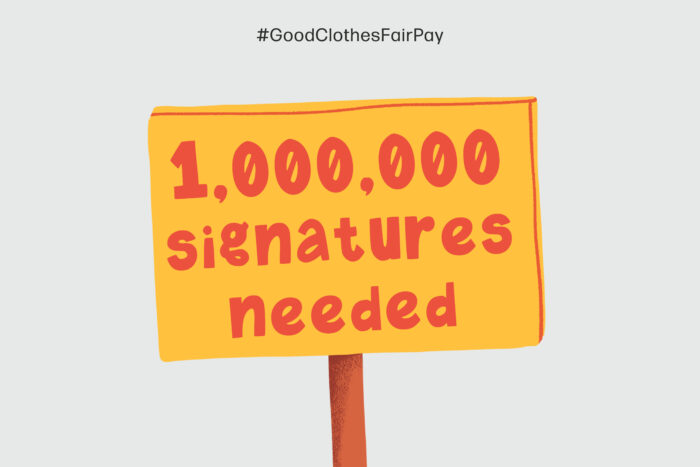
Már jó ideje ismerjük a ‘fenntartható divat’ kifejezést, viszont a legtöbben elég felszínesen. Az Európai Bizottság végre kezébe vette az ügyet, így ezentúl a divat és ruhagyártás folyamatait nemcsak elméletileg, de gyakorlatilag is igyekeznek zöldebbé és átlátatóbbá tenni.
Biztosan mindenkinek ismerősen cseng, hogy ‘fenntartható divatcikk’, mégsem értjük teljesen a koncepciót. Az elsődleges probléma az, hogy az esetek nagy részében a fenntarthatóság csupán olyan új technológiát, anyagokat vagy folyamatokat jelöl, melyek csökkentik a környezetterhelést az előállítás során. Ám az igazság az, hogy ez nem egyenlő a fenntarthatósággal.
A természetre lehet, hogy kedvezőbbek lesznek ezek az új eljárások, viszont egyes esetekben maga a vásárló tapasztalhatja a nem várt effektust, mint bőrproblémák vagy egyéb egészségügyi panaszok. Sok anyag hiába fenntarthatóbb, mégsem bomlik le biológiai úton, és az alulfizetett munkaerő szintén óriási probléma.
A jelenlegi piacon nem léteznek 100%-osan fenntartható márkák, éppen ezért ez egy óriási kihívás minden márka számára.
Hogy lehet a divat ténylegesen fenntartható?
A dizájnerek elsődleges feladata a minőség és a negatív környezeti hatás közti egyensúly megteremtése, a marketing pedig az átláthatóságért felelős: kicsit több „realitytelling”-re lenne szükség „storytelling” helyett. A divatipar az alapvető lételemek felhasználásával dolgozik, melyek több milliárd fajt, köztük minket is életben tartanak. Ezek a víz, a levegő, a föld, az energia.
Az élőlények kihasználása, kizsákmányolása és a környezetszennyezés egyenlő az öngyilkossággal. Valójában Otto von Bush professzor mondja helyesen, amikor fast fashion helyett a „Faust-fashion” kifejezést használja, Goethe művére utalva…
Eljött az idő, hogy ne csak cégek, magánszemélyek foglalkozzanak ezzel az égető problémával! Szerencsére már az amerikai és európai politikában is napirendre tűzték a fenntartható divatot, erős jelzést adva arra, hogy komoly problémával van dolgunk: március 30-án az Európai Bizottság bemutatta a Fenntartható Anyagok és Körforgásuk Stratégiát.
A 10 legfontosabb tényező az Európai Bizottság jelentése alapján
1) Ökodizájn: kötelezően követni kell az EU általi iránymutatást, mely arra utasítja a tervezőket, hogy tartósabb, javíthatóbb, újrahasznosított anyagokból és káros vegyi anyagoktól mentes ruhákat készítsenek.
2) Tilos a megsemmisítés: szörnyű belegondolni, hány tonna textil végzi a szemétben csupán azért, mert nem lett eladva… Ám ez szám is várhatóan csökkenni fog, ugyanis illegális lesz az eladatlan termékek megsemmisítése. Ha erre mégis sor kerülne, azt átláthatóan kell közölni a Bizottsággal.
3) Stop a mikroműanyagoknak: valószínűleg bennünk is megtalálhatóak jelenleg, és mint tudjuk, az egész bolygót ellepték a kis műanyagdarabkák. A tervezőket arra kérik, hogy ne a szintetikus anyagokat részesítsék előnyben, emellett az Európai Bizottság szeretné modernizálni a háztartási és ipari mosógépek szűrési folyamatát is.
4) Átláthatóság: csak semmi titok, a vásárlóknak joguk van tudni, hogy miből, hogyan, hol készült az általuk vásárolt termék.
5) Nincs többé greenwashing: miután egy felmérés során kiderült, hogy a fenntarthatóságról eddig állítottak 40-a% nem igaz, az Európai Bizottság nem fogja engedélyezni a „zöld” jelzőt, csak az olyan márkáknak, amelyek konkrét tervvel rendelkeznek, nem csak a levegőbe beszélnek (például „2030-ra klímasemlegessé válunk”). Minden zöldnek kikiáltott terméket ellenőriznek, hogy bizonyítottan fenntartható-e vagy sem. A márkák a termék tartósságáról és javítási lehetőségeiről is bővebb tájékoztatást fognak adni a vásárlók számára.
6) EPR ‒ EXTENDED PRODUCERS’ RESPONSIBILITY, azaz a gyártó további felelőssége: egy márka felelőssége többé nem ér véget az eladással! A bizottság javaslata szerint egy külön adót vezetnének be a termék utóéletének lekövetésére, lebonyolítására, mely összeg a begyűjtésre és az újrahasznosításra lenne felhasználva segítségképpen.
7) FAST FASHION? OUT OF FASHION: a fast fashion márkákat kérik számon hibás üzleti modelljük miatt, hiszen ők felelnek a fenntarthatatlan árucikkek tömkelegéért, tehát a túltermelésért és a túlfogyasztásért, így a Bizottság csökkentené az egy évben debütáló kollekciók számát.
8) Kutatás és innováció: támogatják az új technológiák és új fenntartható anyagok utáni kutatásokat, és felhívják a figyelmet arra, hogy a PET-palackok újrahasznosítása nem jelent végső megoldást, ugyanis egy újrahasznosított, de hosszú távon mégis kevésbé fenntartható anyag, poliészter jön létre.
9) Társadalmi igazságosság: mint tudjuk, a legtöbb EU-ban kapható terméket EU-n kívüli országokban gyártják, sokszor alulfizetett és/vagy kiskorú munkaerő alkalmazásával. Az Európai Bizottság az emberi jogokat mellőző cégeket nem engedné be az európai piacra, és betiltaná az ily módon előállított termékeket.
10) Vintage vagy szemét? A használtruha-kereskedelem egyre nehezebben működik, ugyanis mire egy ruha elér élete végéhez, már nehezen lehetne újra eladni a rossz minősége miatt. Ettől függetlenül még mindig rengeteg tonna ruha érkezik a nyugati országokból – Ghánába például heti 15 millió ruhadarab jut el. Rengeteg EU-n kívüli ország nem képes eltárolni a kapott termékeket, akár eladási, akár jótékonysági céllal érkeztek azok, így az Európai Bizottság csak olyan országba küldene ruhaszállítmányokat, amelyek azokat megfelelő módon fel tudják használni, és nem egy újabb szeméthegy keletkezik belőle, melyet áttranszferálunk Nyugat-Európából Keletre, vagy épp Afrikába.
A fenntarthatóság kultúrája mint szociális befektetés
Az Európai Bizottság iránymutatásai még nem emelkedtek törvényi szintre ugyan, de nagyon fontos első lépések. Talán kicsit későn került rájuk sor, viszont, ha sikerül azokat foganatosítani, már van okunk az örömre. A márkák éveken keresztül a saját felfogásuk szerint cselekedtek a fenntarthatóság jegyében – sajnos sokszor a saját kényelmüket előtérbe helyezve egyáltalán nem fenntarthatóan –, de szerencsére a Bizottság végre tettre kész.
A mi feladatunk a proaktivitás és a változásra való törekvés vagy hajlandósság, melynek alapja az empátia, nyitottság, együttműködés és a pozitivitás.
A cikk ezen a linken olvasható eredeti nyelven, szerző: Matteo Ward. Fordította: Poszlóczki Flóra
Fair and Sustainable Textiles coalition react to Textile Strategy
The European Commission has today, 30 March 2022, set out plans to bring more sustainability to the textile industry – a sector which remains largely under-regulated. But civil society groups are alarmed that the much-anticipated text misses out key human rights aspects from its focus. With environmental and social sustainability being two sides of the same coin, it is a huge missed opportunity that a chapter of the EU Strategy for Sustainable and Circular Textiles seems to have been lost.
More textile products are being sold at a faster rate than ever before, putting untold pressure on our climate, environment, and people. Europe’s overconsumption of clothes, shoes and household textiles uses up 675 million tonnes of raw materials every year, and poor working conditions and human rights’ violations are rife across the global textile industry. Brands and retailers wield significant power over their business partners resulting in late payments, unilateral contract amendments and prices under the cost of production.
Civil society groups – who have long been calling for a strategy that takes a comprehensive approach by tackling the sector’s environmental and social problems together – issue their first reaction to the Textile Strategy.
Valeria Botta, Environmental Coalition on Standards: “The textile sector has largely been untouched by EU sustainability policies. Today’s decision to include textiles under the Sustainable Products Initiative is a real milestone. We need clothes that are designed to be used, mended and loved for a long time, toxic-free, and produced in a fair and sustainable way. The initiatives presented today can give the right impulse to transform the market, beyond European borders. If the final bill shows bold ambition, we have hopes that Europe will truly hold the textile industry to account for its huge environmental impacts.”
Delphine Williot, Fashion Revolution: “The EU textile strategy released today has failed to capture the beating heart of the textile industry – the people who make our clothes. While efforts to address key issues such as overproduction and overconsumption are a welcome start to address the industry’s severe environmental impact, in categorising the labour of garment workers as ‘unskilled’, this strategy fails to recognise the value of the industry’s labour. The EU’s textile value chains will not be truly sustainable in the absence of efforts to guarantee freedom of association and collective bargaining, which ultimately lead to fair wages for the people who make our clothes.”
Sergi Corbalán, Executive Director, Fair Trade Advocacy Office: “Neither environmental aspects of garment production and human rights of textile workers or cotton farmers will be improved if the root causes of the biggest problems in the industry aren’t addressed: the purchasing practices of brands. Brands use the unequal power balance between them and their suppliers to unilaterally force purchasing practices in their favour, such as setting buying prices lower than the production costs, short lead times or last-minute design changes. These purchasing practices squeeze the margins of a factory, leaving them little to no room to invest in sustainable production or labour conditions, such as a safe working environment or living wages. By not addressing the issue of unfair trading practices, buying prices or living wages and living incomes the “EU Strategy for Sustainable and Circular Textiles” misses a huge piece of the puzzle in making the textile sector circular, fair and sustainable.”
Muriel Treibich, Clean Clothes Campaign International Office: “As the European Commission recently adopted a proposal on corporate sustainability due diligence (CSDD) to ensure companies respect human rights and the environment throughout their value chain, the EU Textile Strategy could have been the place for increased ambition for the textile and apparel sector. Unfortunately, we are disappointed to see that instead of proposing a way forward for tackling the challenges and specificities of the industry – prominence of SMEs, the importance of living wage and living income– the EU Textile Strategy merely refers to ongoing policy initiatives. Million of workers, the backbone of this global textile and apparel industry, needed more from the European Commission”
Ben Vanpeperstraete, Traidcraft Exchange: “The garment sector is notoriously opaque, and more transparency is crucially needed. Several companies, big and small, are already tracing their value chain, and publicly disclosing names, addresses of direct and indirect manufacturers, spinning mills and even cotton fields. Now it’s time for regulators to step in and roll out an ambitious obligation for supply chain mapping and disclosure. Such granular transparency can and should go hand in hand with the digital product passport and should be the basis for meaningful data on wages, water usage, payment terms, etc.”
Tamar Hoek, Solidaridad: “The EU strategy for sustainable textiles offers the opportunity for the European Commission to develop a holistic approach to tackle environmental, social and commercial practices in the textiles supply chain. Design and buying practices have an impact on working conditions, circular business models do not solve exploitation of workers and farmers, or lead to living wages and incomes. In the strategy as presented now the only way to improve social sustainability is through the CSDDD. To make the textile industry truly sustainable a holistic approach is needed that looks at design, buying, production, consumption and recycling from a social, environmental and commercial perspective.”
Emily Macintosh, European Environmental Bureau: “We welcome that the Textile Strategy contains clear plans for binding rules on product design, targets to reuse more textile products and for more of the end of life costs of textile waste to be borne by producers. But you can’t green fast fashion. Today the European Commission has named overproduction as the problem by calling out the number of collections brands put out every year. Now we need to ensure the actions set out in this strategy are translated into real industry accountability for all companies regardless of size, and that there are no get-out-clauses when it comes to the destruction of goods and ensuring fairness for workers.”
Mathieu Rama, RREUSE: “Even though containing encouraging initiatives such as devising ecodesign minimum requirements to extend the life-time of textiles products and safeguarding a share of the proposed harmonised Extended Producer Responsibility fee for waste prevention and preparing for re-use of textiles, the Commission fails to commit to a more protective environment for social enterprises active in the collection, sorting, re–use and resale of textiles. Guidance and encouragements for Member States will not be enough in that regard”.
Judith Kirton-Darling, IndustriAll Europe: “For trade unions, EU sustainable textiles strategy needs to protect people and the planet. Although there are many welcome environmental measures in the Commission’s sustainable textiles communication, the social element is missing yet again! Workers are at the heart of a sustainable and circular textiles sector, and concrete action is needed to ensure that the green transition of the sector is a just transition which means leaving no worker or region behind. We will continue to work with EU policy makers to ensure that workers benefit from the green transition of the textiles sector, and we look forward to playing a key role in the textiles eco-system Transition Pathway which should put European workers at its centre.”
Ecocide.
Few words hold as much power as this one. Ecocide comes from the Greek oikos, which means home; and the Latin occidere, which means to kill. To kill our common home: that is the literal meaning of this mysterious word.
View this post on Instagram
Legally, ecocide is defined as the most serious crimes against the environment. To be more specific, an International panel of experts, initiated by Stop Ecocide International, defined ecocide as “unlawful or wanton acts, committed with knowledge that there is a substantial likelihood of severe and either widespread or long-term damage to the environment being caused by those acts”.
In concrete terms, what are we talking about? Recurring oil spills, the ongoing mass deforestation of the Earth’s primary forests, the emission by only 100 companies of 71% of the world’s greenhouse gas emissions between 1988 and 2015…
These ecocides are the reason for the current ecological and climate crisis. They endanger our capacity to live on this Earth. Yet, to this day, they remain unpunished. Criminal law at the international level, or in most national law, simply does not recognise the crime of ecocide, and lets the people responsible for them free of any accountability.
This is what a 50 years old movement of activists, lawyers and elected representatives from all around the world is trying to change, and the mobilisation is growing! More and more countries, or their parliaments, are supporting the recognition of the crime of ecocide. Citizens are rising to ask political leaders to act to put an end to these crimes and protect the environment and our human rights.
Today, on March 20 2022, citizens all around Europe, in Brussels, Paris, Rome, Amsterdam and Madrid, and around the world are mobilising to ask for the recognition of ecocide in the European Union and at the international level.
What does it have to do with fashion? Well, everything, because recognising ecocide will make companies from all sectors change their behaviour to better take into account the environment.
We know that the fashion industry is a massive polluter. It is the third sector that consumes the most water in the world. It emits every year 1.2 billion tonnes of greenhouse gas, about 10% of the world’s emissions. 500 000 tonnes of microplastics are thrown in the ocean each year due to the production of clothes. And as usual, what endangers the environment also endangers humans: 60 million women textile workers worldwide are exposed to hazardous and toxic chemicals, including pesticides, on a daily basis.
In Bangladesh, rivers are turning black due to the sludge and sewage produced by textile dyeing and processing factories. In Chile, 39,000 tonnes of clothing waste are being stocked in the Atacama desert.
Recognising ecocide and all environmental crimes in law will enable us to prevent these crimes before they happen. It will force companies to change their behaviour, in order not to face criminal sanctions.
Recognising ecocide also means recognising that the destruction of the Earth is one of the most serious crimes, and cannot be ignored anymore. The symbolic power of such recognition should not be underestimated.
As the European Union is currently working on revising its environmental criminal law, I will work tirelessly to include the recognition of ecocide in the text. If you want to support this fight, sign the European petition and share your support on social media with the hashtag #StopEcocideEverywhere.
Together, let’s put an end to ecocide.
Related articles
Fashion brands’ leather sourcing practices are driving deforestation
Fashion unites on a call to action for COP26
Further reading on ecocide
- What is ecocide?
- Making ecocide a crime
- Ecocide: Should killing nature be a crime?
- How a global ecocide law could hold polluters to account




